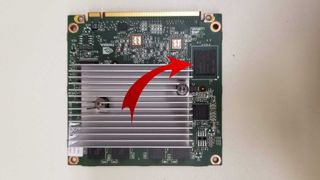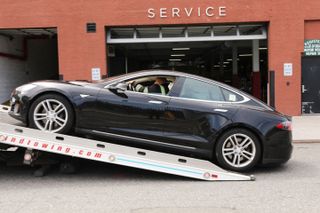Flash Memory Wear Killing Older Tesla's Due to Excessive Data Logging: Report

With electric vehicles now on the market in masses and coming of age, we’re starting to see the real culprits of aging. For internal combustion engines, the types of components that age are quite well known, but we’ve always assumed that electric cars would have much longer lifespans due to the simplicity of their moving parts – or rather, the lack of moving parts. Now, according to a report on InsideEVs, it appears that certain electronics inside older Tesla’s are causing problems for owners.
The culprit resides in the flash memory in the media control unit in older Tesla vehicles based on the MCUv1. As any modern-day vehicle does, Tesla’s log data, but it appears the vehicles log ‘excessive’ amounts of data, and although this gets overwritten in the memory all the time, it does cause wear to the underlying flash. The Tesla firmware wasn't very big at the beginning, so the logged data had lots of spare room to play with, thus allowing the write workload to spread out over a large amount of memory. As new Tesla features have rolled out, though, the firmware has grown, leaving very little room for the logging to take place. That means individual sectors suffer from lots of data being written in a short amount of time, further accelerating the wear.
Because a Tesla is highly dependent on its electronics, once the flash memory in a Tesla’s infotainment unit goes bad, it essentially bricks the entire car.
Flash memory is used in many devices, including the likes of SD cards, SSDs, USB sticks, your phone, and many more kinds of devices, including cars. Flash memory, just like hard drives (and any electronic device, for that matter), has a finite lifespan, and once a block has been written over a certain number of times it eventually is no longer reliable and gets marked as a bad sector. At the start of flash memory’s life, when there are not yet any bad sectors, the memory will maintain its total capacity for quite a long time. However, as these bad sectors start building up, they can eventually impact the total memory capacity. Typically, this is never a problem throughout the useful lifespan of most electronic devices – except with Tesla vehicles, which apparently log excessive amounts of data that leads to premature wear of the memory chips.

A few months ago, when this problem first hit the news, Tesla did not appear to have a fix. Communities created do-it-yourself user guides on how to fix the problem, but Tesla doesn't take well to people working on their own cars, and for many people, dismantling the media control unit and replacing the eMMC storage isn’t an option when they depend on their car.
Today, it looks like Tesla will fix the problem if you're within the warranty, and outside-of-warranty repairs can cost $1,800 to $3,000, depending on your location. Tesla’s method is to replace the entire MCU.
Fortunately, Jason Hughes, known as a ‘Tesla hacker,’ can service these units at a much lower cost. His method is to replace the eMMC on the MCU using specialized equipment, and copy over the unique vehicle identifiers and keys so that users can still access Tesla’s updates and services. If you get to him early enough before the eMMC wears out, he can also change the coding of the vehicle to write the logs to the RAM instead of the flash memory to prevent the wear. This solution comes at the cost of a small performance penalty, though.
Stay on the Cutting Edge
Join the experts who read Tom's Hardware for the inside track on enthusiast PC tech news — and have for over 25 years. We'll send breaking news and in-depth reviews of CPUs, GPUs, AI, maker hardware and more straight to your inbox.

Newer memory in newer Tesla models is more resistant to the wear of repeated rewriting, but there is a catch. Hughes also explained that although this problem currently only impacts older vehicles, it is likely to begin plaguing newer models, too. “Instead of mitigating the issue, it writes even more data to the logs today than ever before. Combined with the max-size firmware images, general caching – map tiles, Autopilot info, music, etc. – this makes every MCUv1 have a high probability of failure,” Hughes told InsideEVs. He further elaborated “MCUv2 and Model 3 also have an issue with excessive logging. Fortunately, they have a larger flash memory size, which should mitigate the issue for the time being. Tesla will still have to eliminate or curb this logging significantly on these if they want them to last, though.”
In short, the newer Tesla’s are still too early in their lifetime to start suffering from memory problems, but unless Tesla does something about the excessive logging behavior, it’s only a matter of when these units will fail. Nevertheless, Elon Musk has commented on the matter in a tweet responding to Hughes, stating it “Should be much better at this point.”
We’re not sure what to make of that as a statement.
Niels Broekhuijsen is a Contributing Writer for Tom's Hardware US. He reviews cases, water cooling and pc builds.
-
rofl.... yet another reason to hate those inferior pieces of junk. soooo expensive...... sooooo full of huge costly failures.Reply
-
hannibal New hightech does not belong to cars unless it does last 30-100 years of normal usage! You don`t buy new card in every two years because cpu is not fast enough. (Or because it starts to weardown...) like you can buy new cellphone.Reply -
macgeek Reply
I think 30-100 years is a bit of an exaggeration. 20-30 years is probably more accurate.hannibal said:New hightech does not belong to cars unless it does last 30-100 years of normal usage! You don`t buy new card in every two years because cpu is not fast enough. (Or because it starts to weardown...) like you can buy new cellphone.
Most Popular


